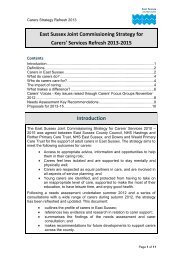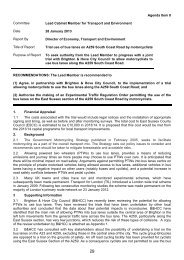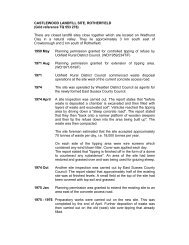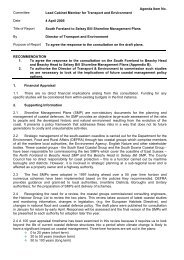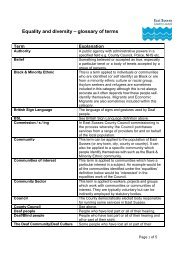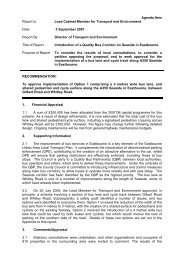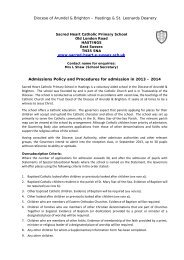Policy on the promotion of dignity at work - East Sussex County ...
Policy on the promotion of dignity at work - East Sussex County ...
Policy on the promotion of dignity at work - East Sussex County ...
- No tags were found...
Create successful ePaper yourself
Turn your PDF publications into a flip-book with our unique Google optimized e-Paper software.
Employee Rel<strong>at</strong>i<strong>on</strong>s Policies <strong>at</strong> <strong>East</strong> <strong>Sussex</strong> <strong>County</strong> Council<str<strong>on</strong>g>Policy</str<strong>on</strong>g> <strong>on</strong> <strong>the</strong> Promoti<strong>on</strong> <strong>of</strong> Dignity <strong>at</strong> Work (Draft)The <strong>County</strong> Council Recognises th<strong>at</strong> all Employees Have <strong>the</strong> Right to Work in anEnvir<strong>on</strong>ment in Which <strong>the</strong> Dignity <strong>of</strong> Individuals is Respected and Which isFree from Discrimin<strong>at</strong>i<strong>on</strong>, Harassment and BullyingKey points• All employees are entitled to be tre<strong>at</strong>ed fairly, c<strong>on</strong>sistently and with <strong>dignity</strong> whilst <strong>at</strong> <strong>work</strong>• The <strong>County</strong> Council will c<strong>on</strong>tinue to promote a <strong>work</strong>ing envir<strong>on</strong>ment which values <strong>the</strong>c<strong>on</strong>tributi<strong>on</strong> all employees can make to <strong>the</strong> efficient delivery <strong>of</strong> quality services• The <strong>County</strong> Council will not c<strong>on</strong>d<strong>on</strong>e bullying or harassing behaviour• Appropri<strong>at</strong>e disciplinary acti<strong>on</strong> will be taken against employees th<strong>at</strong> raise alleg<strong>at</strong>i<strong>on</strong>s th<strong>at</strong>are vex<strong>at</strong>ious or maliciousIntroducti<strong>on</strong><strong>East</strong> <strong>Sussex</strong> <strong>County</strong> Council is committed to elimin<strong>at</strong>ing intimid<strong>at</strong>i<strong>on</strong> in any form. Thefundamental principle underpinning this policy is th<strong>at</strong> discrimin<strong>at</strong>i<strong>on</strong>, harassment orbullying will not be toler<strong>at</strong>ed and acti<strong>on</strong> will be taken where it is seen to exist. Thisacti<strong>on</strong> will be supported by strict disciplinary measures.Discrimin<strong>at</strong>i<strong>on</strong>, bullying and harassment breaches <strong>the</strong> <strong>County</strong> Councils PromotingDiversity and Equality <str<strong>on</strong>g>Policy</str<strong>on</strong>g> and is classified as a serious <strong>of</strong>fence which may result insummary dismissal under <strong>the</strong> Disciplinary Procedure.It is important to provide a <strong>work</strong>ing envir<strong>on</strong>ment in which <strong>the</strong> c<strong>on</strong>tributi<strong>on</strong> <strong>of</strong> allemployees is valued in adding to <strong>the</strong> efficient delivery <strong>of</strong> quality services. It isrecognised th<strong>at</strong> <strong>the</strong> c<strong>on</strong>tributi<strong>on</strong> <strong>of</strong> employees will be effective in c<strong>on</strong>diti<strong>on</strong>s which arefree <strong>of</strong> unnecessary anxiety, stress and fear, and <strong>the</strong>se c<strong>on</strong>diti<strong>on</strong>s are more likely t<strong>of</strong>lourish in an envir<strong>on</strong>ment which respects <strong>the</strong> rights <strong>of</strong> individuals and is c<strong>on</strong>cerned withmaintaining <strong>the</strong>ir <strong>dignity</strong> <strong>at</strong> <strong>work</strong>. Failure to do so can result in tensi<strong>on</strong> in <strong>the</strong> <strong>work</strong>place,increased absence and staff turnover, poor performance, ill-health, low morale, difficultemployee rel<strong>at</strong>i<strong>on</strong>s, potential litig<strong>at</strong>i<strong>on</strong> and increased costs.Who Does <strong>the</strong> <str<strong>on</strong>g>Policy</str<strong>on</strong>g> Apply to?D R A F TThis policy applies to all employees with <strong>the</strong> excepti<strong>on</strong> <strong>of</strong> teaching and support staffemployed directly in Schools. The principles <strong>of</strong> this policy will also apply to any dealingsemployees might have with <strong>County</strong> Councillors, service users, c<strong>on</strong>tractors andmembers <strong>of</strong> <strong>the</strong> public.It is recommended for adopti<strong>on</strong> in schools.C:\Documents and Settings\richardm\Desktop\reports\G15Jul2005Item7DignityAtWorkAppendix.doc Page 1<strong>of</strong> 7
Employee Rel<strong>at</strong>i<strong>on</strong>s Policies <strong>at</strong> <strong>East</strong> <strong>Sussex</strong> <strong>County</strong> CouncilWh<strong>at</strong> is Harassment?Harassment is usually directed <strong>at</strong> those individuals who are vulnerable or in a minority.It is generally described as unwanted or unjustified behaviour which affects <strong>the</strong> <strong>dignity</strong><strong>of</strong> people in <strong>the</strong> <strong>work</strong>place, and which has <strong>the</strong> effect <strong>of</strong> cre<strong>at</strong>ing an intimid<strong>at</strong>ing, hostile,degrading, humili<strong>at</strong>ing, thre<strong>at</strong>ening or <strong>of</strong>fensive envir<strong>on</strong>ment. Harassment is defined inall strands <strong>of</strong> equality legisl<strong>at</strong>i<strong>on</strong> and may be <strong>on</strong> <strong>the</strong> grounds <strong>of</strong> gender, ethnic origin,disability, sexual orient<strong>at</strong>i<strong>on</strong>, religi<strong>on</strong> or belief or age.Differences in <strong>at</strong>titude, background or culture can mean th<strong>at</strong> wh<strong>at</strong> is perceived asharassment by <strong>on</strong>e pers<strong>on</strong> may not seem so to ano<strong>the</strong>r. Harassment will be c<strong>on</strong>sideredto have occurred if <strong>the</strong> pers<strong>on</strong> c<strong>on</strong>cerned perceives it to have occurred even if this isnot <strong>the</strong> intenti<strong>on</strong> behind it.The following interpret<strong>at</strong>i<strong>on</strong>s and examples <strong>of</strong> harassment may be helpful indetermining whe<strong>the</strong>r harassment has taken place;Harassment can take many forms and may or may not involve bullying but will involvesome acti<strong>on</strong>, behaviour, comment or physical c<strong>on</strong>tact which is found objecti<strong>on</strong>able orwhich causes <strong>of</strong>fence.Harassment can be defined as an uninvited, unreciproc<strong>at</strong>ed and unwelcome behaviourwhich is <strong>of</strong>fensive to <strong>the</strong> pers<strong>on</strong> involved and causes th<strong>at</strong> pers<strong>on</strong> to feel thre<strong>at</strong>ened,humili<strong>at</strong>ed, p<strong>at</strong>r<strong>on</strong>ised or embarrassed and it can cre<strong>at</strong>e a stressful and debilit<strong>at</strong>ing<strong>work</strong> envir<strong>on</strong>ment. Some general examples <strong>of</strong> unacceptable harassing behaviourinclude (this is not an exhaustive list);• intrusive or anti-social behaviour such as staring, pestering, unwarranted spying;• behaviour th<strong>at</strong> undermines ano<strong>the</strong>r;• breaches <strong>of</strong> c<strong>on</strong>fidentiality;• c<strong>on</strong>tinued suggesti<strong>on</strong>s for social activity outside <strong>the</strong> <strong>work</strong>place after it has beenmade clear th<strong>at</strong> such suggesti<strong>on</strong>s are unwelcome;• <strong>the</strong> use <strong>of</strong> <strong>of</strong>fensive language or gossip.• requests for sexual favours, including implied or overt promises <strong>of</strong> preferentialtre<strong>at</strong>ment or thre<strong>at</strong>s c<strong>on</strong>cerning present or future employment st<strong>at</strong>us;• sexually-orient<strong>at</strong>ed jibes, innuendo or jokes;• <strong>the</strong> use <strong>of</strong> ‘affecti<strong>on</strong><strong>at</strong>e’ names such as ‘gorgeous’ or ‘darling’• unwanted physical c<strong>on</strong>tact;• comments <strong>on</strong> dress, physical <strong>at</strong>tributes, pers<strong>on</strong>ality or sexual activityWh<strong>at</strong> is Bullying?D R A F TBullying is <strong>the</strong> intimid<strong>at</strong>i<strong>on</strong> or belittling <strong>of</strong> some<strong>on</strong>e through <strong>the</strong> misuse <strong>of</strong> power orpositi<strong>on</strong> which leaves <strong>the</strong> recipient feeling hurt, upset, vulnerable or helpless. It is <strong>of</strong>teninextricably linked to <strong>the</strong> areas <strong>of</strong> harassment described above. People affected bybullying <strong>of</strong>ten feel <strong>the</strong> m<strong>at</strong>ter appears trivial or th<strong>at</strong> <strong>the</strong>y may have difficulty in describingit.However, bullying is not restricted to those in positi<strong>on</strong>s <strong>of</strong> power. It may also occurbecause minorities or those deemed as vulnerable or weak, are bullied by <strong>the</strong> majorityC:\Documents and Settings\richardm\Desktop\reports\G15Jul2005Item7DignityAtWorkAppendix.doc Page 2<strong>of</strong> 7
Employee Rel<strong>at</strong>i<strong>on</strong>s Policies <strong>at</strong> <strong>East</strong> <strong>Sussex</strong> <strong>County</strong> Councilor by those who perceived <strong>the</strong>mselves as str<strong>on</strong>ger. It is intended to undermine,humili<strong>at</strong>e, denigr<strong>at</strong>e or injure <strong>the</strong> recipientThe following are examples <strong>of</strong> bullying:• derog<strong>at</strong>ory name-calling;• arbitrarily, unjustifiably and persistently changing <strong>work</strong> targets, guidelines anddeadlines;• setting some<strong>on</strong>e up to fail in <strong>the</strong>ir job, e.g. by not passing <strong>on</strong> importantinform<strong>at</strong>i<strong>on</strong> or by feeding false inform<strong>at</strong>i<strong>on</strong>;• mimicry or ridicule;• written insults or jokes (including e-mail);• ridicule <strong>of</strong> an individual for gender or cultural differences;• shouting or raising <strong>on</strong>e’s voice <strong>at</strong> any pers<strong>on</strong>, in public or in priv<strong>at</strong>e• exclusi<strong>on</strong> from normal <strong>work</strong>place c<strong>on</strong>vers<strong>at</strong>i<strong>on</strong> or social events;• unfair alloc<strong>at</strong>i<strong>on</strong> <strong>of</strong> <strong>work</strong> and resp<strong>on</strong>sibilities;• embarrassing or humili<strong>at</strong>ing people in fr<strong>on</strong>t <strong>of</strong> colleagues;• persistent, unfounded criticism, accus<strong>at</strong>i<strong>on</strong>s and spreading malicious rumours;• verbal abuse and thre<strong>at</strong>s;• incitement <strong>of</strong> o<strong>the</strong>rs to commit any <strong>of</strong> <strong>the</strong> above;The essential characteristics <strong>of</strong> harassment or bullying are th<strong>at</strong> <strong>the</strong> <strong>of</strong>fendingbehaviours are unwanted by <strong>the</strong> recipient and would be regarded as harassment byany reas<strong>on</strong>able pers<strong>on</strong>.It should be noted th<strong>at</strong> whilst employees are encouraged to raise any c<strong>on</strong>cerns <strong>the</strong>ymay have it should be understood th<strong>at</strong> many management activities, such as instig<strong>at</strong>ingdisciplinary proceedings, m<strong>on</strong>itoring performance, dealing with <strong>at</strong>tendance issues,changing deadlines and priorities and resp<strong>on</strong>ding to service needs do not, if handledreas<strong>on</strong>ably, c<strong>on</strong>stitute harassment or bullying.Resp<strong>on</strong>sibilities <strong>of</strong> ManagersIt falls <strong>on</strong> managers to set <strong>the</strong> standards and do all <strong>the</strong>y can to ensure th<strong>at</strong> staff andpotential staff are tre<strong>at</strong>ed fairly and courteously and are given <strong>the</strong> support and respect<strong>the</strong>y need to do <strong>the</strong>ir jobs.Every manager has an oblig<strong>at</strong>i<strong>on</strong> to prevent harassment and bullying and to takeimmedi<strong>at</strong>e acti<strong>on</strong> <strong>on</strong>ce it has been identified, whe<strong>the</strong>r or not a complaint has beenmade.If managers are aware th<strong>at</strong> <strong>the</strong>re are rel<strong>at</strong>i<strong>on</strong>ship problems within <strong>the</strong>ir teams it is <strong>the</strong>irresp<strong>on</strong>sibility to address <strong>the</strong>se issues immedi<strong>at</strong>ely before <strong>the</strong>y escal<strong>at</strong>e and formalacti<strong>on</strong> ensues.Alleg<strong>at</strong>i<strong>on</strong>s <strong>of</strong> acts <strong>of</strong> this n<strong>at</strong>ure, received ei<strong>the</strong>r informally or formally must be dealtwith promptly and sensitively.Managers should aim to;D R A F T• set an example and promote a <strong>work</strong>ing envir<strong>on</strong>ment where harassment isviewed as unacceptable and where staff feel free to challenge harassmentC:\Documents and Settings\richardm\Desktop\reports\G15Jul2005Item7DignityAtWorkAppendix.doc Page 3<strong>of</strong> 7
Employee Rel<strong>at</strong>i<strong>on</strong>s Policies <strong>at</strong> <strong>East</strong> <strong>Sussex</strong> <strong>County</strong> Council• ensure th<strong>at</strong> employees are aware <strong>of</strong> <strong>the</strong> policy and <strong>the</strong> notes <strong>of</strong> guidance andth<strong>at</strong> it is covered in discussi<strong>on</strong>s during <strong>the</strong> inducti<strong>on</strong> process and <strong>at</strong> appraisal orsupervisi<strong>on</strong> meetings;• implement <strong>the</strong> policy within <strong>the</strong>ir areas <strong>of</strong> resp<strong>on</strong>sibility and provide appropri<strong>at</strong>eawareness and training <strong>on</strong> key issues;• tre<strong>at</strong> seriously and take immedi<strong>at</strong>e and appropri<strong>at</strong>e acti<strong>on</strong> to investig<strong>at</strong>e anycomplaints <strong>of</strong> harassment (where possible to tackle and resolve cases before aformal complaint becomes necessary)• ensure th<strong>at</strong> all employees are aware <strong>of</strong> <strong>the</strong> support net<strong>work</strong>s available to <strong>the</strong>mResp<strong>on</strong>sibilities <strong>of</strong> StaffEvery employee has a pers<strong>on</strong>al resp<strong>on</strong>sibility to behave in a way th<strong>at</strong> is not <strong>of</strong>fensive too<strong>the</strong>rs. Employees should NOT discrimin<strong>at</strong>e against, harass or bully o<strong>the</strong>r members <strong>of</strong>staff. Any employee found doing so, following an investig<strong>at</strong>i<strong>on</strong>, will be subject to <strong>the</strong>organis<strong>at</strong>i<strong>on</strong>’s Disciplinary <str<strong>on</strong>g>Policy</str<strong>on</strong>g> and Procedure and in certain cases, such acts maybe regarded as Gross Misc<strong>on</strong>duct and may lead to summary dismissal.An employee who becomes aware <strong>of</strong> harassment or bullying occurring to <strong>the</strong>mselves orano<strong>the</strong>r member <strong>of</strong> staff should bring <strong>the</strong> m<strong>at</strong>ter to <strong>the</strong> <strong>at</strong>tenti<strong>on</strong> <strong>of</strong> his/her manager.Employees are encouraged to support colleagues who may be experiencingharassment and are c<strong>on</strong>sidering making a complaint.Support Net<strong>work</strong>s<strong>East</strong> <strong>Sussex</strong> <strong>County</strong> Council has an Occup<strong>at</strong>i<strong>on</strong>al Health nurse who is trained toprovide impartial advice and inform<strong>at</strong>i<strong>on</strong>, to discuss opti<strong>on</strong>s and <strong>of</strong>fer support to staffexperiencing harassment or bullying in <strong>the</strong> <strong>work</strong>place but not to act as an advoc<strong>at</strong>e.The nurse has received training to help give independent advice, listen to, support andcoach staff to help <strong>the</strong>m take wh<strong>at</strong>ever acti<strong>on</strong> is decided up<strong>on</strong>.D R A F TThe <strong>County</strong> Council also has a strictly c<strong>on</strong>fidential Counselling Net<strong>work</strong> which isavailable to both employees experiencing bullying or harassment and employeesagainst whom such an accus<strong>at</strong>i<strong>on</strong> has been made. The Staff Welfare Service willprovide guidance and referral for c<strong>on</strong>fidential counselling.The uni<strong>on</strong>s also provide advice and support to members if <strong>the</strong>y are experiencing or areaccused <strong>of</strong> harassment <strong>at</strong> <strong>work</strong>.Process for Dealing with Complaints <strong>of</strong> Harassment or BullyingThe primary aim <strong>of</strong> <strong>the</strong> process is to achieve a resoluti<strong>on</strong> <strong>of</strong> a complaint <strong>of</strong> harassmentor bullying, so th<strong>at</strong> all those involved can put <strong>the</strong> m<strong>at</strong>ter behind <strong>the</strong>m and begin to <strong>work</strong>amicably and effectively toge<strong>the</strong>r.Pers<strong>on</strong>nel Officers can give general advice to staff and may advise or assist thosemanagers dealing with Dignity <strong>at</strong> Work issues but <strong>the</strong>y will not be resp<strong>on</strong>sible forc<strong>on</strong>ducting <strong>the</strong> investig<strong>at</strong>i<strong>on</strong>s.Every<strong>on</strong>e involved in <strong>the</strong> process must respect <strong>the</strong> need for c<strong>on</strong>fidentiality.C:\Documents and Settings\richardm\Desktop\reports\G15Jul2005Item7DignityAtWorkAppendix.doc Page 4<strong>of</strong> 7
Employee Rel<strong>at</strong>i<strong>on</strong>s Policies <strong>at</strong> <strong>East</strong> <strong>Sussex</strong> <strong>County</strong> CouncilIt is recognised th<strong>at</strong> <strong>on</strong> occasi<strong>on</strong> Dignity <strong>at</strong> Work alleg<strong>at</strong>i<strong>on</strong>s are raised as a result <strong>of</strong>managers addressing performance c<strong>on</strong>cerns and should any such issues be raised<strong>the</strong>se will be addressed appropri<strong>at</strong>ely.At any stage <strong>of</strong> <strong>the</strong> process <strong>the</strong> complainant or <strong>the</strong> accused may feel th<strong>at</strong> <strong>the</strong>y need <strong>the</strong>help <strong>of</strong> an independent pers<strong>on</strong> before deciding <strong>on</strong> <strong>the</strong> best course <strong>of</strong> acti<strong>on</strong>. They canc<strong>on</strong>tact <strong>on</strong>e <strong>of</strong> <strong>the</strong> Occup<strong>at</strong>i<strong>on</strong>al Health nurses, <strong>the</strong>ir trade uni<strong>on</strong>, or, altern<strong>at</strong>ively <strong>the</strong>ymay c<strong>on</strong>tact Staff Welfare Services for referral to a counsellor.The complainant must be assured th<strong>at</strong> s/he will not be discrimin<strong>at</strong>ed against orvictimised for raising <strong>the</strong> complaint. C<strong>on</strong>fidentiality will be observed throughout and <strong>the</strong>need for any disclosure <strong>of</strong> <strong>the</strong> details <strong>of</strong> <strong>the</strong> case will be discussed and agreed.<strong>East</strong> <strong>Sussex</strong> <strong>County</strong> Council’s bullying and harassment procedure has two stages,informal and formal. Unless <strong>the</strong> alleg<strong>at</strong>i<strong>on</strong>s are <strong>of</strong> a very serious n<strong>at</strong>ure, all employeesraising a Dignity <strong>at</strong> Work claim will be expected to complete <strong>the</strong> informal stage <strong>of</strong> <strong>the</strong>procedure before progressing to formal stage.In <strong>the</strong> event th<strong>at</strong> an employee raises a Dignity <strong>at</strong> Work complaint in <strong>the</strong> course <strong>of</strong> <strong>the</strong>disciplinary process, or <strong>the</strong>re remains an outstanding complaint, <strong>the</strong> Council willnormally suspend c<strong>on</strong>sider<strong>at</strong>i<strong>on</strong> <strong>of</strong> <strong>the</strong> complaint until <strong>the</strong> outcome <strong>of</strong> <strong>the</strong> disciplinaryprocess is known; each case will, however, be c<strong>on</strong>sidered <strong>on</strong> its merits to ensure th<strong>at</strong><strong>the</strong> Council is acting reas<strong>on</strong>ably.Stage 1 – Informal stage1.1 Direct ApproachAn employee who feels th<strong>at</strong> s/he is being subjected to harassment or bullying would beexpected to <strong>at</strong>tempt to resolve <strong>the</strong> m<strong>at</strong>ter informally in <strong>the</strong> first instance, unlessexcepti<strong>on</strong>al circumstances prevent this. In some cases it may be possible and sufficientfor him/her to explain clearly to <strong>the</strong> pers<strong>on</strong>(s) engaged in <strong>the</strong> unwanted activities th<strong>at</strong><strong>the</strong> behaviour is unwelcome, th<strong>at</strong> it <strong>of</strong>fends or makes him/her uncomfortable.D R A F TIf <strong>at</strong> <strong>the</strong> initial informal discussi<strong>on</strong> stage <strong>the</strong> complainant finds <strong>the</strong> circumstances aretoo difficult or embarrassing to approach <strong>the</strong> harasser al<strong>on</strong>e, <strong>the</strong> complainant may wishto be accompanied by a Trade Uni<strong>on</strong> represent<strong>at</strong>ive or colleague.The complainant may wish to write a letter to <strong>the</strong> harasser as an altern<strong>at</strong>ive toc<strong>on</strong>fr<strong>on</strong>ting <strong>the</strong>m in pers<strong>on</strong>.Even if <strong>the</strong> complainant does not take formal acti<strong>on</strong> s/he should be advised to keep arecord <strong>of</strong> any incidents, detailing when, where, wh<strong>at</strong> occurred, and witnesses (if any).This may be required if <strong>the</strong>re is a subsequent repetiti<strong>on</strong> and it is decided th<strong>at</strong> formalacti<strong>on</strong> is necessary.1.2 St<strong>at</strong>ements for <strong>the</strong> Manager (or manager’s manager)If <strong>the</strong> unwanted behaviour c<strong>on</strong>tinues after your initial request or you do not receive as<strong>at</strong>isfactory resp<strong>on</strong>se it will be necessary to involve your line manager so th<strong>at</strong> s/he cangive advice and support and help m<strong>on</strong>itor <strong>the</strong> situ<strong>at</strong>i<strong>on</strong>. If <strong>the</strong> complaint rel<strong>at</strong>es to <strong>the</strong>C:\Documents and Settings\richardm\Desktop\reports\G15Jul2005Item7DignityAtWorkAppendix.doc Page 5<strong>of</strong> 7
Employee Rel<strong>at</strong>i<strong>on</strong>s Policies <strong>at</strong> <strong>East</strong> <strong>Sussex</strong> <strong>County</strong> Councilc<strong>on</strong>duct <strong>of</strong> <strong>the</strong> complainant’s manager, <strong>the</strong> complainant may choose to discuss <strong>the</strong>m<strong>at</strong>ter with his/her manager’s line manager.When making a complaint, in order th<strong>at</strong> <strong>the</strong> issue can be dealt with promptly andefficiently, employees will be required to make a st<strong>at</strong>ement th<strong>at</strong> covers <strong>the</strong> followingareas;• clear, specific alleg<strong>at</strong>i<strong>on</strong>s against <strong>the</strong> named pers<strong>on</strong> or people;• where possible, d<strong>at</strong>es, times and witnesses to any incidents with direct quotes;• factual descripti<strong>on</strong> <strong>of</strong> events;• an indic<strong>at</strong>i<strong>on</strong> <strong>of</strong> how each incident made <strong>the</strong> complainant feel;• any documentary evidence, and;• details <strong>of</strong> any acti<strong>on</strong> th<strong>at</strong> <strong>the</strong> complainant, or o<strong>the</strong>rs, has already taken.The Manager with advice from Pers<strong>on</strong>nel will ensure th<strong>at</strong> <strong>the</strong>y have enough inform<strong>at</strong>i<strong>on</strong>from <strong>the</strong> individual making <strong>the</strong> complaint to agree a st<strong>at</strong>ement which can be presentedto <strong>the</strong> pers<strong>on</strong> against whom <strong>the</strong> alleg<strong>at</strong>i<strong>on</strong>s are being made. The complainant will beasked to check and sign <strong>the</strong> st<strong>at</strong>ement. The manager may wish to meet with <strong>the</strong>complainant to discuss <strong>the</strong> st<strong>at</strong>ement but this should not delay <strong>the</strong> processunnecessarily.Using <strong>the</strong> st<strong>at</strong>ement <strong>the</strong> Manager will inform <strong>the</strong> pers<strong>on</strong> against whom <strong>the</strong> alleg<strong>at</strong>i<strong>on</strong>shave been made, <strong>the</strong> n<strong>at</strong>ure <strong>of</strong> <strong>the</strong> complaint th<strong>at</strong> has been made and <strong>the</strong> intenti<strong>on</strong> todeal with <strong>the</strong> m<strong>at</strong>ter informally (Stage 1 <strong>of</strong> <strong>the</strong> procedure). At <strong>the</strong> meeting <strong>the</strong> managershould ascertain whe<strong>the</strong>r <strong>the</strong> alleged harasser/bully agrees th<strong>at</strong> <strong>the</strong> behaviouroccurred, irrespective <strong>of</strong> intenti<strong>on</strong>. This will depend <strong>on</strong> <strong>the</strong> seriousness <strong>of</strong> <strong>the</strong> incidentand <strong>the</strong> Pers<strong>on</strong>nel Officer’s advice should be taken as to <strong>the</strong> appropri<strong>at</strong>e course <strong>of</strong>acti<strong>on</strong>. This meeting should take place within 10 <strong>work</strong>ing days <strong>of</strong> recording <strong>the</strong>st<strong>at</strong>ement <strong>of</strong> complaint.A written record <strong>of</strong> <strong>the</strong> agreed outcome <strong>of</strong> <strong>the</strong> meeting should be provided to bothparties1.3 Medi<strong>at</strong>i<strong>on</strong>If m<strong>at</strong>ters have not been resolved previously, before moving to <strong>the</strong> formal stage, unless<strong>the</strong> <strong>County</strong> Council believes it would not be helpful in resolving <strong>the</strong> situ<strong>at</strong>i<strong>on</strong>, bo<strong>the</strong>mployees will be expected to undergo medi<strong>at</strong>i<strong>on</strong>.If <strong>the</strong> behaviour is successfully dealt with informally (<strong>at</strong> Stage 1 <strong>of</strong> <strong>the</strong> procedure) <strong>the</strong>situ<strong>at</strong>i<strong>on</strong> should be closely m<strong>on</strong>itored by <strong>the</strong> manager.In situ<strong>at</strong>i<strong>on</strong>s where <strong>the</strong> manager decides th<strong>at</strong> a complaint cannot be easily resolvedinformally (<strong>at</strong> Stage 1), or where <strong>the</strong> alleg<strong>at</strong>i<strong>on</strong> is <strong>of</strong> such a serious n<strong>at</strong>ure, <strong>the</strong> m<strong>at</strong>terwill be dealt with <strong>at</strong> Stage 2 <strong>of</strong> <strong>the</strong> process.Stage 2 – Formal StageD R A F T• If <strong>the</strong> informal approach has not resolved <strong>the</strong> situ<strong>at</strong>i<strong>on</strong> to <strong>the</strong> complainant’ss<strong>at</strong>isfacti<strong>on</strong> or <strong>the</strong> harasser has already been approached but has not stopped <strong>the</strong>harassment <strong>the</strong>n <strong>the</strong> complainant has <strong>the</strong> right to pursue his or her complaint viaStage Two under <strong>the</strong> Formal Stage <strong>of</strong> <strong>the</strong> <strong>County</strong> Council’s Grievance Procedure.Altern<strong>at</strong>ively an investig<strong>at</strong>i<strong>on</strong> may be instig<strong>at</strong>ed under <strong>the</strong> formal stage <strong>of</strong> <strong>the</strong> <strong>County</strong>Council’s Disciplinary <str<strong>on</strong>g>Policy</str<strong>on</strong>g> and Procedure. If this is <strong>the</strong> case <strong>the</strong> manager shouldC:\Documents and Settings\richardm\Desktop\reports\G15Jul2005Item7DignityAtWorkAppendix.doc Page 6<strong>of</strong> 7
Suspensi<strong>on</strong>Employee Rel<strong>at</strong>i<strong>on</strong>s Policies <strong>at</strong> <strong>East</strong> <strong>Sussex</strong> <strong>County</strong> Councilensure th<strong>at</strong> <strong>the</strong> employee clearly understands wh<strong>at</strong> <strong>the</strong> procedure will be and whowill have resp<strong>on</strong>sibility for wh<strong>at</strong>. Managers should always seek advice fromPers<strong>on</strong>nel as to which is <strong>the</strong> most appropri<strong>at</strong>e course <strong>of</strong> acti<strong>on</strong>. Pers<strong>on</strong>nel will makea pr<strong>of</strong>essi<strong>on</strong>al judgement about whe<strong>the</strong>r <strong>the</strong> issue is <strong>on</strong>e <strong>of</strong> serious misc<strong>on</strong>duct byan employee and should be investig<strong>at</strong>ed via <strong>the</strong> Disciplinary procedure or whe<strong>the</strong>r<strong>the</strong> issue is <strong>on</strong>e where an employee believes th<strong>at</strong> <strong>the</strong>y have been tre<strong>at</strong>ed unfairly inrel<strong>at</strong>i<strong>on</strong> to <strong>the</strong>ir terms and c<strong>on</strong>diti<strong>on</strong>s <strong>of</strong> service or o<strong>the</strong>r <strong>work</strong> rel<strong>at</strong>ed issues in whichcase <strong>the</strong> Grievance procedure should be used.Managers should seek advice from Pers<strong>on</strong>nel <strong>on</strong> <strong>the</strong> opti<strong>on</strong>s and way forward beforereaching a decisi<strong>on</strong> <strong>on</strong> whe<strong>the</strong>r it is appropri<strong>at</strong>e for <strong>the</strong> complainant and <strong>the</strong> alleged<strong>of</strong>fender to c<strong>on</strong>tinue <strong>work</strong>ing toge<strong>the</strong>r during <strong>the</strong> investig<strong>at</strong>i<strong>on</strong>. It may be advisable for<strong>the</strong> dur<strong>at</strong>i<strong>on</strong> <strong>of</strong> <strong>the</strong> investig<strong>at</strong>i<strong>on</strong> to:• suspend <strong>the</strong> alleged <strong>of</strong>fender <strong>on</strong> full pay;• temporarily move ei<strong>the</strong>r <strong>the</strong> complainant or alleged <strong>of</strong>fender in accordance with<strong>the</strong> terms <strong>of</strong> <strong>the</strong>ir employment; and/or• grant <strong>the</strong> complainant special leave.Suspensi<strong>on</strong> is a neutral act carried out in order to ensure a fair and thoroughinvestig<strong>at</strong>i<strong>on</strong> <strong>of</strong> <strong>the</strong> claim. All suspensi<strong>on</strong>s should be closely m<strong>on</strong>itored and reviewedand should not go any l<strong>on</strong>ger than absolutely necessary. Managers must ensureregular communic<strong>at</strong>i<strong>on</strong> with any employees <strong>on</strong> suspensi<strong>on</strong> throughout <strong>the</strong> dur<strong>at</strong>i<strong>on</strong> <strong>of</strong><strong>the</strong> investig<strong>at</strong>i<strong>on</strong>.Any disciplinary hearing against a perpetr<strong>at</strong>or or complainant should be held under <strong>the</strong><strong>County</strong> Council’s formal Disciplinary <str<strong>on</strong>g>Policy</str<strong>on</strong>g> and Procedure.Subsequent Acti<strong>on</strong>Following a resoluti<strong>on</strong> <strong>at</strong> <strong>the</strong> formal stages a manager should carefully m<strong>on</strong>itor th<strong>at</strong> <strong>the</strong>harassment has stopped.Malicious ComplaintsHaving c<strong>on</strong>ducted an investig<strong>at</strong>i<strong>on</strong> under ei<strong>the</strong>r <strong>the</strong> Disciplinary <str<strong>on</strong>g>Policy</str<strong>on</strong>g> and Procedureor <strong>the</strong> Grievance Procedure, should <strong>the</strong> complaint be found to be malicious, i.e. th<strong>at</strong> <strong>the</strong>complaint was entirely false and made with <strong>the</strong> deliber<strong>at</strong>e intenti<strong>on</strong> <strong>of</strong> having acti<strong>on</strong>taken against ano<strong>the</strong>r employee, <strong>the</strong>n <strong>the</strong> complainant should <strong>the</strong>mselves be dealt withunder <strong>the</strong> Disciplinary Procedure.D<strong>at</strong>e last reviewedD R A F TC:\Documents and Settings\richardm\Desktop\reports\G15Jul2005Item7DignityAtWorkAppendix.doc Page 7<strong>of</strong> 7



